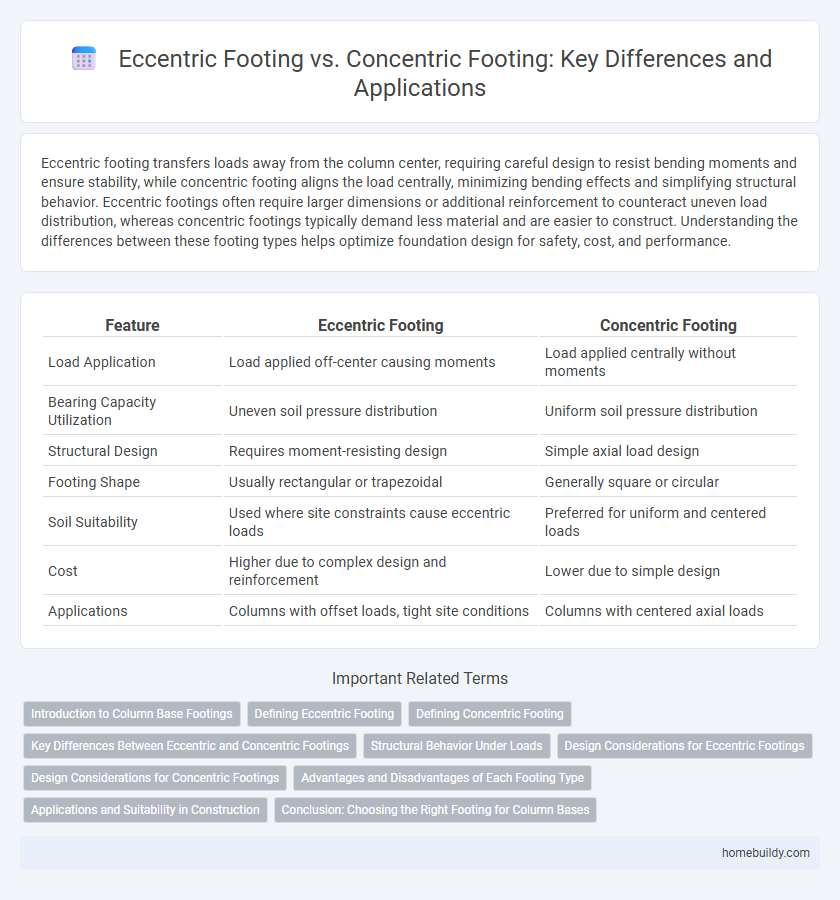Eccentric footing transfers loads away from the column center, requiring careful design to resist bending moments and ensure stability, while concentric footing aligns the load centrally, minimizing bending effects and simplifying structural behavior. Eccentric footings often require larger dimensions or additional reinforcement to counteract uneven load distribution, whereas concentric footings typically demand less material and are easier to construct. Understanding the differences between these footing types helps optimize foundation design for safety, cost, and performance.
Table of Comparison
| Feature | Eccentric Footing | Concentric Footing |
|---|---|---|
| Load Application | Load applied off-center causing moments | Load applied centrally without moments |
| Bearing Capacity Utilization | Uneven soil pressure distribution | Uniform soil pressure distribution |
| Structural Design | Requires moment-resisting design | Simple axial load design |
| Footing Shape | Usually rectangular or trapezoidal | Generally square or circular |
| Soil Suitability | Used where site constraints cause eccentric loads | Preferred for uniform and centered loads |
| Cost | Higher due to complex design and reinforcement | Lower due to simple design |
| Applications | Columns with offset loads, tight site conditions | Columns with centered axial loads |
Introduction to Column Base Footings
Column base footings serve as crucial structural elements that transfer column loads to the foundation soil. Eccentric footing is designed when the load's line of action does not pass through the centroid of the footing, causing moments that require asymmetric reinforcement and sizing adjustments. Concentric footing supports vertical loads applied centrally, ensuring uniform stress distribution beneath the base with simplified design and efficient load transfer.
Defining Eccentric Footing
Eccentric footing is a type of foundation designed to support columns where the load is applied away from the center, resulting in an uneven distribution of pressure on the soil. Unlike concentric footing, which bears the load symmetrically, eccentric footing counters moments caused by offset loads, preventing tilting or undue stress. This footing type is crucial in structures where design constraints or site conditions prevent placing columns directly above the footing center.
Defining Concentric Footing
Concentric footing refers to a type of foundation where the column load is applied directly at the center of the footing, ensuring uniform distribution of stress and minimizing bending moments. This footing design typically results in symmetrical footing dimensions, providing structural stability and efficient load transfer to the soil. Concentric footings are commonly used in uniform soil conditions with vertical load applications to prevent uneven settlement and structural tilting.
Key Differences Between Eccentric and Concentric Footings
Eccentric footing transfers column loads away from the footing center, causing uneven soil pressure and requiring larger footing areas to counteract moment forces. Concentric footing distributes loads uniformly through the column base, maintaining symmetrical stress and typically resulting in smaller, more economical footings. The key difference lies in load positioning relative to the column axis, affecting footing design and soil bearing requirements.
Structural Behavior Under Loads
Eccentric footing experiences uneven load distribution, resulting in combined vertical and moment forces that induce bending and shear stresses in the foundation soil and structure. Concentric footing carries axial loads centered under the column, producing uniform pressure and minimizing bending moments, ensuring stable load transfer. Structural behavior under loads for eccentric footing requires careful consideration of overturning moments and soil bearing capacity to prevent differential settlement or tilting.
Design Considerations for Eccentric Footings
Eccentric footings require careful design considerations to accommodate moments induced by off-center loads, ensuring stability and preventing overturning. The footing size must be increased on the loaded side to balance the eccentric moment, and soil bearing capacity must be evaluated to avoid excessive settlement. Reinforcement detailing must address tensile stresses and ensure adequate anchorage to resist bending effects unique to eccentric loadings.
Design Considerations for Concentric Footings
Design considerations for concentric footings prioritize uniform load distribution directly beneath the column, requiring precise assessment of soil bearing capacity and column load to prevent differential settlement. Structural stability depends on ensuring that the footing size accommodates the axial loads without eccentricity, maintaining symmetry to avoid bending moments. Proper reinforcement detailing and adequate thickness are crucial to resist shear forces and prevent punching shear failure in concentric footing designs.
Advantages and Disadvantages of Each Footing Type
Eccentric footing offers the advantage of accommodating columns located near property lines or adjacent structures, reducing the footprint area and minimizing load distribution issues but can lead to uneven soil pressure and potential differential settlement. Concentric footing provides uniform load distribution beneath centrally loaded columns, ensuring structural stability and simplified design; however, it requires more space and may be impractical for columns near boundaries. Selecting between eccentric and concentric footing depends on site constraints, load characteristics, and structural requirements, balancing soil bearing capacity with load transfer efficiency.
Applications and Suitability in Construction
Eccentric footing is ideal for structures subjected to uneven loads or near property lines where load distribution must counteract moments and prevent tilting. Concentric footing suits centrally loaded columns in open areas with uniform soil conditions, providing balanced load transfer with minimal bending moments. Applications for eccentric footings include boundary columns and retaining walls, while concentric footings are preferred for interior columns in buildings and warehouses.
Conclusion: Choosing the Right Footing for Column Bases
Eccentric footing is best suited for columns subjected to moments causing uneven load distribution, ensuring structural stability by counteracting bending forces. Concentric footing is ideal for centrally loaded columns where axial forces are uniformly distributed, offering simplicity and cost-effectiveness. Selecting the appropriate footing hinges on load conditions, soil bearing capacity, and structural design requirements to optimize safety and efficiency.
eccentric footing vs concentric footing Infographic

 homebuildy.com
homebuildy.com